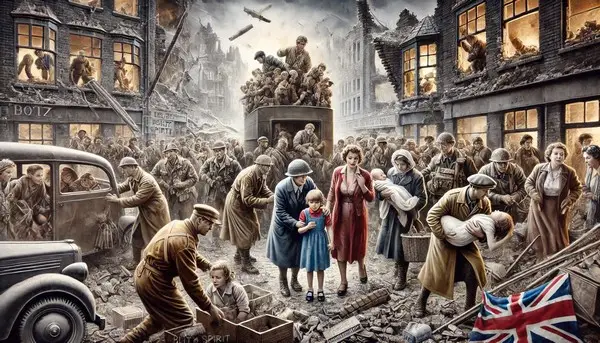Table of Contents
- Introduction
- Historical Context: The Blitz as Total‑War Milieu
- Theoretical Frameworks for Analysing Collective Resilience
- Empirical Manifestations of the Blitz Spirit
- Critical Perspectives: Deconstructing the Myth
- Methodological Reflections
- Contemporary Invocations of the Blitz Spirit
- Cultural Commodification and Heritage Economies
- The Blitz Spirit and British National Identity
- Conclusion: Sociological Lessons and Future Horizons
Introduction
The phrase “the Blitz spirit” conjures enduring images of Londoners huddled on Underground platforms, factories hammering on despite shattered roofs, and milkmen stepping over rubble to complete their rounds. In popular discourse the term denotes pluck, stoicism and neighbour‑helping‑neighbour altruism. Yet, for sociology, the Blitz spirit is not mere folk nostalgia; it is a dense sociocultural formation whose reproduction across eight decades offers a privileged window into the micro‑foundations of solidarity, the symbolic architecture of nationalism, and the dialectic between lived experience and myth‑making.
Historical Context: The Blitz as Total‑War Milieu
Duration, Geography, and Scale
Between September 7 1940 and May 11 1941 the Luftwaffe flew more than 71 major night‑raids on London and over 130 heavy raids on cities including Coventry, Liverpool, Glasgow, Cardiff, and Belfast. Scholars estimate that by the cessation of the main campaign, 43,500 civilians had been killed, 139,000 injured, and 2 million homes damaged or destroyed. The displacement of whole neighbourhoods created what Zygmunt Bauman would later call “liquid insecurity”: social ties became fluid as families evacuated, factories decentralised, and class boundaries encountered the churn of spatial reorganisation.
Social Institutions Under Stress
The Blitz operated as a total‑war crucible, simultaneously pressurising family life, religious practice, labour relations, and political legitimacy. Sunday services migrated to crypt chapels; marriage rates spiked as couples sought emotional certainty; and women’s paid labour participation rose from 26 % pre‑war to over 40 % by late 1941. This re‑calibration of gendered labour norms provides an early case of role strain and compensatory adaptation in Parsons’s functionalist lexicon, but also heralds later feminist critiques of how “temporary” gains were rolled back in the 1950s.
Knowledge Production in Real Time
Social knowledge about civilian morale was not produced retrospectively: it emerged in medias res through Mass‑Observation diaries, Home Intelligence reports, and BBC listener surveys. These assemblages of field notes, coded telegrams, and morale graphs constituted what Bruno Latour would deem an “immutable mobile”—facts that moved quickly across ministries to justify policy. Recognising this reflexive loop is critical: measurement influenced management, and management, in turn, shaped the phenomenon labelled the Blitz spirit.
Theoretical Frameworks for Analysing Collective Resilience
To interrogate the Blitz spirit’s generative logics, we mobilise an eclectic theoretical toolkit.
Durkheimian Collective Effervescence Revisited
Durkheim’s concept of collective effervescence—moments when ordinary routines are suspended and emotional electricity surges through the social body—maps neatly onto nightly shelter rituals. However, recent scholarship nuances the idea by foregrounding affective atmospheres: the mix of fear‑odour, dim light, and communal singing that rendered spaces simultaneously sacred and claustrophobic. These atmospheres, Sara Ahmed argues, are sticky; their affective residues persist, feeding post‑war nostalgia.
Functionalist Equilibration and Systems Theory
Parsonsian functionalism interprets ad‑hoc innovations—mobile canteen services, school‑in‑exile schemes, and the Ministry of Food’s “British Restaurants”—as emergent subsystems restoring equilibrium. Later systems theorist Niklas Luhmann deepens this view by highlighting “double contingency”: civilians adjusted expectations of one another under radical uncertainty, gradually stabilising interaction patterns that minimised panic.
Symbolic Interactionism and Definition of the Situation
From a symbolic interactionist stance, the Blitz spirit crystallised through endless negotiations of meaning: was an early return to work bravery or foolhardiness? Did sleeping in the Tube denote communal belonging or destitution? Interactionists insist that these meanings were contested in micro‑settings—a point confirmed by oral histories recounting classed disputes over shelter etiquette.
Social Network Theory and Distributed Resilience
Where earlier accounts focus on norms and symbols, network analysis maps the structural pathways through which information, material aid, and emotional support travelled. Dense local networks of kin and neighbours expedited resource pooling, while bridging ties—shop‑steward committees liaising with municipal authorities—enabled up‑scaling of solutions. The Blitz thus exemplifies a multilayered network of contingency plans pre‑figuring modern resilience planning.
Risk Society and Reflexive Modernisation
Ulrich Beck’s thesis that late modernity is characterised by manufactured risks invites a retrospective extension: while bombs were externally produced, civilian exposure was unevenly distributed by urban planning decisions embedding prior class inequalities. The East End bore disproportionate casualties, presaging later debates on environmental justice and risk externalisation.
Collective Trauma and Narrative Repair
Kai Erikson conceptualises collective trauma as damage to the fundamental tissue of social life. In the Blitz, trauma was modulated by narrative repair: storytelling circles, church sermons, and press features that re‑sequenced fragments of loss into plots of endurance. Narrative, then, is itself an informal institution of resilience.
Cultural Memory and the Post‑Memory Generation
Pierre Nora’s lieux de mémoire approach is enriched by Marianne Hirsch’s notion of post‑memory, whereby children born after the Blitz “remember” it through mediated representations—murals, history lessons, and grand‑parental anecdotes. The Blitz spirit, therefore, occupies overlapping memory regimes: lived, cultural, and prosthetic.
Empirical Manifestations of the Blitz Spirit
Get the full article AD FREE. Join now for full access to all premium articles.
View Plans & Subscribe Already a member? Log in.





